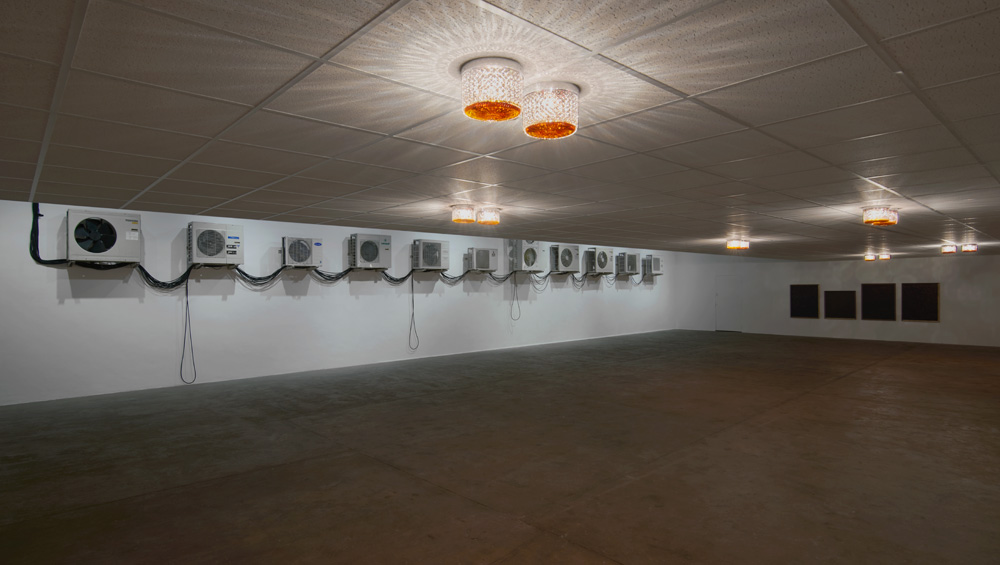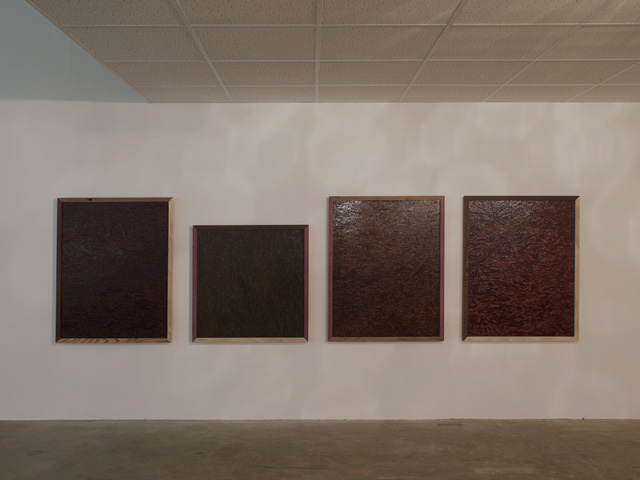
Ima-Abasi Okon, Infinite Slippage: nonRepugnant Insolvencies T!-a!-r!-r!-y!-i!-n!-g! as Hand Claps of M’s Hard’Loved’Flesh [I’M irreducibly-undone because] —Quantum Leanage-Complex-Dub, 2019. Installation view, Chisenhale Gallery, 2019. Commissioned and produced by Chisenhale Gallery, London. Courtesy of the artist. Photo: Andy Keate.
Chisenhale Gallery, London
28 June – 1 September 2019
by VERONICA SIMPSON
It is probably just as well that Ima-Abasi Okon has not captioned the works in her first solo show at the Chisenhale Gallery in blocks of text on the wall, as is the gallery norm. There would be no elegant or economical way to represent the title of the first of these new, specially commissioned works you encounter in her installation: a false ceiling of classic, off-white, modular tiles, of the kind that are ubiquitous in any low-grade office building, or institutional reception area or waiting room (think hospitals, schools, GP surgeries, airport security) anywhere in the world. The title runs to almost one and a half pages of tiny, closely typed script in the accompanying A5 leaflet, comprising numbers and the words “with peace” and “without peace”.
This is not – if you read the fascinating interview with Chisenhale curator Ellen Greig that is printed in the same leaflet – mere pretentiousness or provocation. Okon articulates clearly why her titles don’t conform to any neat, cute or pithy form. She says: “I like to have a structure that is able to contain everything that I am thinking about in that moment … All of these words, and how they are expressed, are equally important, there’s no hierarchy. They all arrive at the same speed, like 20 darts coming towards you at the same time.” All her works here have long, unwieldy, poetic and associative titles, liberally splashed with unorthodox punctuations. For example, the title of the show is printed in the leaflet exactly as follows:
Infinite Slippage: nonRepugnant Insolvencies
T!-a!-r!-r!-y!-i!-n!-g! as Hand Claps of M’s
Hard’Loved’Flesh
[I’M irreducibly-undone because]
– Quantum Leanage-Complex-Dub

Ima-Abasi Okon, Mahalia’s CounterApparatus: A profound Intimacy of inter—locking detail— I want it Alot More M-o-i-s-t, Wett’er, What! What! Yes! (Redmahogany&Mahogany&Kolonial&Walnut), 2019. Commissioned and produced by Chisenhale Gallery, London. Courtesy of the artist. Photo: Andy Keate.
There is a refreshing bolshiness about these cumbersome appellations. If an artist doesn’t want to play ball with boringly descriptive or witty titles, or abdicate responsibility with a simple “untitled”, why not go all out in a blaze of idiosyncrasy or individuality. Okon tells Greig she used to struggle with the idea that there was a “proper” way of acting in the art world. “I actually want to do away with that preconception of what a certain professional space warrants of me, because I don’t find it helpful.”
![Ima-Abasi Okon, Infinite Slippage: nonRepugnant Insolvencies T!-a!-r!-r!-y!-i!-n!-g! as Hand Claps of M’s Hard’Loved’Flesh [I’M irreducibly-undone because] —Quantum Leanage-Complex-Dub, 2019. Installation view, Chisenhale Gallery, 2019. Commissioned and produced by Chisenhale Gallery, London. Courtesy of the artist. Photo: Andy Keate.](/images/articles/o/090-okon-ima-abasi-2019/05__Ima-Abasi-Okon-at-Chisenhale-Gallery_Photo-Andy-Keate.jpg)
Ima-Abasi Okon, Infinite Slippage: nonRepugnant Insolvencies T!-a!-r!-r!-y!-i!-n!-g! as Hand Claps of M’s Hard’Loved’Flesh [I’M irreducibly-undone because] —Quantum Leanage-Complex-Dub, 2019. Installation view, Chisenhale Gallery, 2019. Commissioned and produced by Chisenhale Gallery, London. Courtesy of the artist. Photo: Andy Keate.
There are clues in these titles, should you wish to extract them. The use of the word “tarrying” (if you strip out the exclamation marks and hyphens) is telling. “Tarrying is an important part of this new body of work,” she says. “Tarrying in terms of a stilled intensity of waiting, of slowing down. An intended dwelling on something, or waiting for something to arrive. Through both the work in the exhibition and through this simple wordplay, I’m trying to make a place palpable for something else.”
![Ima-Abasi Okon, When the —[After-the-world presocial vivid therenessssss and ongoinglyyy] — is in the system, 2019. Commissioned and produced by Chisenhale Gallery, London. Courtesy of the artist. Photo: Andy Keate.](/images/articles/o/090-okon-ima-abasi-2019/10__Ima-Abasi-Okon-at-Chisenhale-Gallery_Photo-Andy-Keate.jpg)
Ima-Abasi Okon, When the —[After-the-world presocial vivid therenessssss and ongoinglyyy] — is in the system, 2019. Commissioned and produced by Chisenhale Gallery, London. Courtesy of the artist. Photo: Andy Keate.
And what an interesting “place” she has made. The aforementioned ceiling tiles have been set quite low over the visitors’ heads as they enter – low enough to feel oppressive, as per the aforementioned waiting-room experience. But this false ceiling is adorned with ornate, paired, cut-crystal lamps, the intricate, faceted surfaces of which spray complicated patterns across the expanse of cheap tiles. An amber liquid is pooled in their bases – a mixture of palm oil and cognac (Courvoisier VS Cognac, to be specific). So the light they cast is a rich, bronze glow, elevating the setting to something approaching glamour. Okon describes these lamps as a form of “hacking”, telling Greig: “How do you exist and operate in a space that is structurally life-limiting? You can hack it.”
![Ima-Abasi Okon, When the —[After-the-world presocial vivid therenessssss and ongoinglyyy] — is in the system, 2019. Commissioned and produced by Chisenhale Gallery, London. Courtesy of the artist. Photo: Andy Keate.](/images/articles/o/090-okon-ima-abasi-2019/08__Ima-Abasi-Okon-at-Chisenhale-Gallery_Photo-Andy-Keate.jpg)
Ima-Abasi Okon, When the —[After-the-world presocial vivid therenessssss and ongoinglyyy] — is in the system, 2019. Commissioned and produced by Chisenhale Gallery, London. Courtesy of the artist. Photo: Andy Keate.
The tiles themselves have also been “hacked” - coated thinly in a curious mixture of morphine, insulin, ultrasound gel and gold. Okon’s practice is very much about interrogating how we assign value to objects. This layering of both precious and utilitarian substances and objects runs throughout her visual and material language. These lamps, however, have an additional, autobiographical element, she tells Greig, inspired by the crystal decanters that her parents bring out as a gesture of welcome when they entertain; a flashback to a more old-fashioned kind of courtesy, “bringing out the best” tableware for guests. The pairing of them – not a configuration you would find in any normal lighting plan – is flagging up their part in a social ritual; also, “these types of decanters are normally sold with two glasses,” she says. The practice of making these cut-crystal objects is as fascinating to her as their uses: she sought out two traditional glass-cutting and glass-blowing craftsmen in the West Midlands, whose skills have been honed over 30 years or more, but which are no longer required in our throwaway, Ikea-ified consumer culture. Look closely: you will see that every pair is different.
![Ima-Abasi Okon, Infinite Slippage: nonRepugnant Insolvencies T!-a!-r!-r!-y!-i!-n!-g! as Hand Claps of M’s Hard’Loved’Flesh [I’M irreducibly-undone because] —Quantum Leanage-Complex-Dub, 2019. Installation view, Chisenhale Gallery, 2019. Commissioned and produced by Chisenhale Gallery, London. Courtesy of the artist. Photo: Andy Keate.](/images/articles/o/090-okon-ima-abasi-2019/13__Ima-Abasi-Okon-at-Chisenhale-Gallery_Photo-Andy-Keate.jpg)
Ima-Abasi Okon, Infinite Slippage: nonRepugnant Insolvencies T!-a!-r!-r!-y!-i!-n!-g! as Hand Claps of M’s Hard’Loved’Flesh [I’M irreducibly-undone because] —Quantum Leanage-Complex-Dub, 2019. Installation view, Chisenhale Gallery, 2019. Commissioned and produced by Chisenhale Gallery, London. Courtesy of the artist. Photo: Andy Keate.
The precious and the utilitarian are juxtaposed in other interesting ways here: 11 old-fashioned air-conditioning units line the wall opposite the ceiling. Their mechanisms have been stripped down to just the fan element, and these fans whirr and stop at varying speeds and irregular intervals, alternating with a slowed-down soundtrack playing from speakers placed inside six of them. The actual soundtrack is the pop song Adorn by Miguel, but you would be hard pushed to recognise it. Instead, what emerges is a friendly, burbling, chirruping noise, erupting from individual speakers in a manner that is almost like language. While they are placed along a unified line, they are all different shapes and sizes, their brands worn like name tags - Toshiba, Carrier, Fonko, Fujitsu, Mitsubishi, Haier. They have an appealing, anthropomorphic individuality: a chorus line of machines, linked by a necklace of black cables looped between their grubby, metal casings.
These units articulate Okon’s interest in expressing or evoking the body indirectly. These, she says, are “containers that have the potential to hold, give and receive. This comes down to breath. What happens when someone’s breath is obstructed or someone’s capacity to breathe is obstructed, limited or is policed.
“Every moment, depending on where you are in the space, you might feel like a light touch of air, like you’re touched by something. So there’s also this play in terms of where the body is and what body is being privileged. And I want to privilege and make people notice this space above the ceiling.”
![Ima-Abasi Okon, Infinite Slippage: nonRepugnant Insolvencies T!-a!-r!-r!-y!-i!-n!-g! as Hand Claps of M’s Hard’Loved’Flesh [I’M irreducibly-undone because] —Quantum Leanage-Complex-Dub, 2019. Installation view, Chisenhale Gallery, 2019. Commissioned and produced by Chisenhale Gallery, London. Courtesy of the artist. Photo: Andy Keate.](/images/articles/o/090-okon-ima-abasi-2019/14__Ima-Abasi-Okon-at-Chisenhale-Gallery_Photo-Andy-Keate.jpg)
Ima-Abasi Okon, Infinite Slippage: nonRepugnant Insolvencies T!-a!-r!-r!-y!-i!-n!-g! as Hand Claps of M’s Hard’Loved’Flesh [I’M irreducibly-undone because] —Quantum Leanage-Complex-Dub, 2019. Installation view, Chisenhale Gallery, 2019. Commissioned and produced by Chisenhale Gallery, London. Courtesy of the artist. Photo: Andy Keate.
Okon is referring to the void above the false ceiling, directly opposite this group of machines. To Okon, the void represents: “The space that is hidden. Negated and concluded as being unnecessary, excessive to the requirement. I am thinking about this as a proxy for … people who live in social death and are eliminated from the category of the human; those who are marginalised and kept on the periphery. A zone of banishment. I’m interested in that zone. It is rich with knowledges that aren’t caught up in normalised disciplinary boundaries.”
Perhaps there is more work to be done to make that particular thought or association more apparent, but there is a creepy quality to that empty, overlooked space, even if (or especially because) it is overlooked by machines. I confess I wasn’t initially won over by the collection of oriented strand boards at the end of the gallery, thickly painted with varnish, and framed in exotic woods (mahogany, walnut, tulipwood, wenge and zebrano). What is of interest here: the frame being more precious than its contents? A celebration of human and machine care and craft in the densely pressed, varnished, “leftover” wood particles, compared with the slow, organic, biologically crafted qualities of natural wood? These works are part of a series she has titled Mahalia Jackson. She tells Greig: ‘Whenever Mahalia is referenced in the title, know that there’s a conjuring of hope.” She also tells her: “Go and sit with Mahalia, everything you need to know about how these works operate or attempt to, is with her.”
As instructed, I went home and spent the evening listening to Mahalia Jackson. I was none the wiser about the strand boards, but it was an evening well spent.